广州中医药大学第二临床医学院中医诊断学2018年考博真题试卷
历年考博中内试题

2005年一、名解无痰不做眩、调气则后重自除,行血则便脓自愈、治萎独取阳明二、简答1、呕吐、噎膈、呃逆的病机异同2、消渴病机要点3、蠲痹汤的适应证4、胸痹常用的治法有哪些?三、论述1、五种从痰治喘的方剂,证候特点2、论述水肿,四种毒瘀血有关的证候,病机转化及证候学特点3、益气摄血法治血证的几个表现2006年一、词解(15分)培土生金呕吐癫痫狂泻南补北痨瘵二、问答(20分)1、血热妄行、气不摄血有何不同?二者能否同时出现?2、肺、脾、肾气虚有何不同?辨治特点?3、古医籍阐述水肿治法,结合原文说明。
三、简述(20分)某男,50岁,素有高血压史十余年,晨起突然头晕,伴恶呕,继则视一为二,写出中医诊断,简述诊治思路。
(一男,50岁,高血压病史5年。
今晨起床后,感觉头晕,视物旋转,如坐车船,视一为二。
请你作出中医诊断,并对其作出具体诊治。
)1、如何鉴别胸痹、心痛与胃脘痛?(胸痹心痛与胃脘痛的鉴别。
)治湿方法有哪些?代表方剂、主治、证候特点?(治湿有那些方法,并写出代表方剂,及其临床如何应用。
)2、简述中医药对消渴的优势所在四、病案分析女,78岁,慢支40年,肺心病5年。
3天前咳加重,伴发热、心悸、烦躁,初咳白色泡沫痰,易咯出,1天前痰黄粘,不易咯出,喘不能平卧,恶寒,四肢不温,胸膺喘闷,口唇紫绀,四肢浮肿,指之凹陷,不易恢复,继则神识朦胧,昼睡夜烦。
2006年另一个版本一、名词解释(3分/题)呕吐、泻南补北、培土生金、癫狂痫、痨瘵二、简答题(5分/题)1、何谓瘟疫?2、一男,50岁,高血压病史5年。
今晨起床后,感觉头晕,视物旋转,如坐车船,视一为二。
请你作出中医诊断,并对其作出具体诊治。
3、胸痹心痛与胃脘痛的鉴别。
4、血热妄行和气不摄血的机制是什么?二者是否可以并见?三、论述题(10分/题)1、关于水肿的治疗,请你结合古代文献作出论述。
2、治湿有那些方法,并写出代表方剂,及其临床如何应用。
3、结合临床请你谈谈中医药在治疗消渴的优势所在。
广中医二院临床轮训学生考试试卷附答案
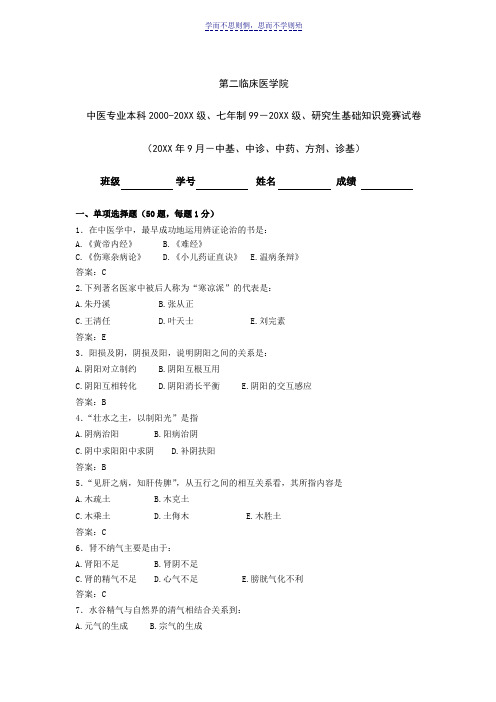
第二临床医学院中医专业本科2000-20XX级、七年制99-20XX级、研究生基础知识竞赛试卷(20XX年9月-中基、中诊、中药、方剂、诊基)班级学号姓名成绩一、单项选择题(50题,每题1分)1.在中医学中,最早成功地运用辨证论治的书是:A.《黄帝内经》B.《难经》C.《伤寒杂病论》D.《小儿药证直诀》E.温病条辩》答案:C2.下列著名医家中被后人称为“寒凉派”的代表是:A.朱丹溪B.张从正C.王清任D.叶天士E.刘完素答案:E3.阳损及阴,阴损及阳,说明阴阳之间的关系是:A.阴阳对立制约B.阴阳互根互用C.阴阳互相转化D.阴阳消长平衡E.阴阳的交互感应答案:B4.“壮水之主,以制阳光”是指A.阴病治阳B.阳病治阴C.阴中求阳阳中求阴D.补阴扶阳答案:B5.“见肝之病,知肝传脾”,从五行之间的相互关系看,其所指内容是A.木疏土B.木克土C.木乘土D.土侮木E.木胜土答案:C6.肾不纳气主要是由于:A.肾阳不足B.肾阴不足C.肾的精气不足D.心气不足E.膀胱气化不利答案:C7.水谷精气与自然界的清气相结合关系到:A.元气的生成B.宗气的生成C.营气的生成D.卫气的生成E.中气的生成答案:B8.循行过程中具有离、入、出、合特点的是:A.经别 B.别络 C.经筋 D.皮部 E.十二经脉答案:A9.风性主动,在临床上常见:A.恶寒无汗B.眩晕抽搐C.鼻塞喉痒D.关节曲伸不利E.关节疼痛游走不定答案:B10.见肝之病,先实其脾气,这种治疗属于:A.未病先防B.治病求本C.扶正祛邪D.先安未受邪之地E.急则治其标答案:D11.我国现存最早的舌诊专著是:A.《伤寒舌鉴》B.《舌苔统志》C.《彩图辨舌指南》D.《敖氏伤寒金镜录》答案:D12.戴阳证的面色是:A.面色晦暗B.面红目赤C.面红如妆D.面色潮红答案:C13.从舌象辨虚实,以下哪一项最佳:A.舌苔的厚薄B.舌质的老嫩C.舌质的颜色D.舌苔的颜色答案:B14.漫肿无头,肤色不变,不热少痛者为:A.痈B.疖C.疔D.疽答案:D15.下列除__外,均是舌体短缩的主病:A.寒凝筋脉B.痰浊内阻C.阴亏已极D.气血俱虚答案:C16.巅顶头痛属A.太阳经B.阳明经C.厥阴经D.少阴经答案:C17.腹痛,泻下黄糜而排便不爽为:A.大肠湿热B.肝郁乘脾C.中气不足D.脾肾阳虚答案:A18.脉来举、按均有力为:A.滑脉B.紧脉C.弦脉D.实脉答案:D19. 按虚里除___外,均属正常:A.按之应手B.动微不显C.动而不紧D.缓而不急答案:D20.自汗出,易感冒,面色淡白,短气,倦怠乏力,舌淡脉弱,此属:A.风邪束表B.卫气不固C.内伤表虚D.外感表虚答案:C21.属暑邪性质和致病特点的是:A.易生风动血B.性粘滞C.性干涩,易伤津液D.多挟湿答案:D22.下列除___外,均是亡阳证的临床表现:A.面色苍白B.汗出而热C.呼吸微弱D.四肢厥冷答案:B23. 用咸味药治瘰疬、痰火结核、瘿瘤等证,是取其:A. 泻下之功B. 软坚散结之功C. 宣泄之功D. 发散之功E. 补益之功答案:B24.既能发表散风,透疹消疮,炒炭又能止血的药物是:A. 桂枝B. 防风C. 荆芥D. 香薷E. 羌活答案:C25.下列除哪项外均是薄荷的功效?A. 疏散风热B. 疏肝解郁C. 清利头目D. 利咽透疹E. 解毒散肿答案:E26. 既能清肝火,又能散郁结的药物是:A. 栀子B. 桑叶C. 青葙子D. 夏枯草E. 决明子答案:D27. 既能凉血退蒸,又善清肺降火的药物是:A. 白薇B. 知母C. 黄芩D. 芦根E. 地骨皮答案:E28.治诸骨哽咽,最宜用:A. 独活B. 威灵仙C. 白花蛇D. 川乌E. 木瓜答案:B29.既善利水渗湿,又能泄肾与膀胱之热的药物是:A. 猪苓B. 知母C. 黄柏D. 泽泻E. 木通答案:D30. 枳实的功效是:A. 化痰消积, 破气活血B. 化痰消积, 破气除痞C. 化痰消积, 健脾和中D. 降气化痰, 泻下攻积E. 降气化痰, 疏肝理气答案:B31. 功能化瘀止血止痛,为伤科要药的药物是:A. 蒲黄B. 赤芍C. 牡丹皮D. 三七E. 花蕊石答案:D32.功能平肝潜阳、软坚散结、收敛固涩的药物是:A. 鳖甲B. 龟板C. 牡蛎D. 龙骨E. 石决明答案:C33.下列除()外,均是当归的功效:A. 补血调经B. 活血C. 止痛D. 益精填髓E. 润肠通便答案:D34.既能补血、止血,又能滋阴润燥的佳品是:A. 生地黄B. 熟地黄C. 黄精D. 阿胶E. 桑椹答案:D35.补益剂服药时间宜:A.食后服 B.空腹服 C.食前服 D.临睡服 E.不拘时服答案:B36.具有解表散寒,温肺化饮功用的方剂是:A.小青龙汤 B.麻黄汤 C.麻杏薏甘汤 D.桂枝加芍药汤 E.九味羌活汤答案: A37.体现“逆流挽舟”法的方剂是:A.银翘散 B.麻杏甘石汤 C.败毒散 D.麻黄汤 E.桂枝汤答案: C38.济川煎组成药物中无:A.大黄 B.当归 C.牛膝 D.肉苁蓉 E.泽泻答案:A39.具有温阳健脾,行气利水功用的方是:A.真武汤B.五苓散C.实脾散D.平胃散E.半夏厚朴汤答案:C40.患者初见寒热往来,胸胁苦满,因泻后而成心下痞硬,胀满而不痛,时有呕吐,肠鸣泄泻,舌苔微黄而腻,脉弦。
中医内科学考博论述题
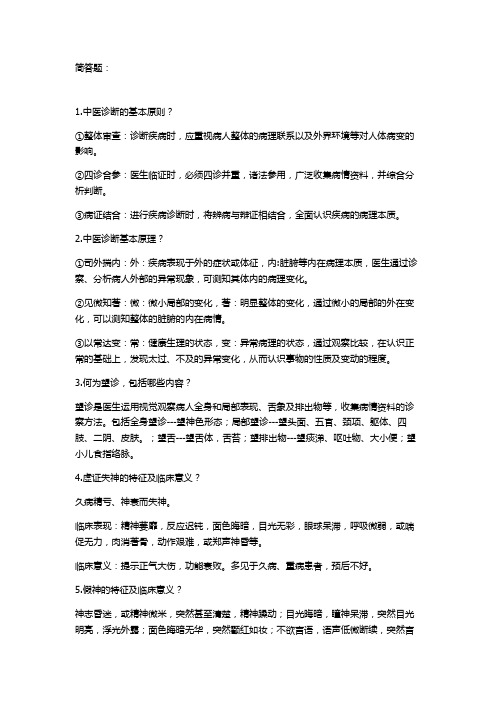
简答题:1.中医诊断的基本原则?①整体审查:诊断疾病时,应重视病人整体的病理联系以及外界环境等对人体病变的影响。
②四诊合参:医生临证时,必须四诊并重,诸法参用,广泛收集病情资料,并综合分析判断。
③病证结合:进行疾病诊断时,将辨病与辩证相结合,全面认识疾病的病理本质。
2.中医诊断基本原理?①司外揣内:外:疾病表现于外的症状或体征,内:脏腑等内在病理本质,医生通过诊察、分析病人外部的异常现象,可测知其体内的病理变化。
②见微知著:微:微小局部的变化,著:明显整体的变化,通过微小的局部的外在变化,可以测知整体的脏腑的内在病情。
③以常达变:常:健康生理的状态,变:异常病理的状态,通过观察比较,在认识正常的基础上,发现太过、不及的异常变化,从而认识事物的性质及变动的程度。
3.何为望诊,包括哪些内容?望诊是医生运用视觉观察病人全身和局部表现、舌象及排出物等,收集病情资料的诊察方法。
包括全身望诊---望神色形态;局部望诊---望头面、五官、颈项、躯体、四肢、二阴、皮肤。
;望舌---望舌体,舌苔;望排出物---望痰涕、呕吐物、大小便;望小儿食指络脉。
4.虚证失神的特征及临床意义?久病精亏、神衰而失神。
临床表现:精神萎靡,反应迟钝,面色晦暗,目光无彩,眼球呆滞,呼吸微弱,或喘促无力,肉消著骨,动作艰难,或郑声神昏等。
临床意义:提示正气大伤,功能衰败。
多见于久病、重病患者,预后不好。
5.假神的特征及临床意义?神志昏迷,或精神微米,突然甚至清楚,精神躁动;目光晦暗,瞳神呆滞,突然目光明亮,浮光外露;面色晦暗无华,突然颧红如妆;不欲言语,语声低微断续,突然言语不休;毫无食欲,或食量减少,突然欲进食或暴食。
提示脏腑精气衰竭,正气将脱,阴不敛阳,虚阳外越,阴阳即将离绝,属于病危。
6.假神与重病好转如何鉴别?假神见于垂危的病人,在治疗无效的前提下,突然出现局部症状的暂时性“好转”,与整体病情恶化不相符。
重病好转是在治疗有效的基础上,从个别症状的改善,逐渐发展为全身的、稳步的好转,与整体状况好转相一致,如食欲渐渐增加,面色渐渐红润。
广州中医药大学成人高等教育一学年第一学期期末考试 《中医诊断学》试卷

广州中医药大学成人高等教育一学年第一学期期末考试《中医诊断学》试卷您的姓名: [填空题] *_________________________________学号 [填空题] *_________________________________年级 [填空题] *_________________________________专业 [填空题] *_________________________________一、单项选择题(本题共30小题,每小题1分,共 30 分)1、下列哪一项不属于失神? [单选题] *A、神志昏迷B、撮空理线C、面色晦暗D、颧红如妆(正确答案)E、语言失伦2、面色萎黄,主病是: [单选题] *A、肾阳虚衰B、脾胃气虚(正确答案)C、脾胃湿热D、脾虚湿蕴E、阴虚火旺3、小儿昏睡露睛为: [单选题] *A、肝虚B、肾虚C、肺虚D、脾虚(正确答案)E、心虚4、舌苔黄腻多主: [单选题] *A、风热外侵B、热盛伤津C、寒湿内困D、暑热偏盛E、湿热内蕴(正确答案)5、瘳瘤多见于: [单选题] *A、气滞血瘀B、阳虚阴盛C、肝郁气结痰凝(正确答案)D、感受风火时毒E、脾虚湿盛6、胖人的体质特点是: [单选题] *A、相火易亢B、气胜形C、易聚湿生痰(正确答案)D、中焦有火E、气血亏虚7、神识昏糊,胡言乱语,声高有力的是: [单选题] *A、郑声(正确答案)B、谐语C、独语D、狂言E、短气8、头痛以两侧为主,属: [单选题] *A、阳明经B、太阳经C、少阳经(正确答案)D、太阴经E、厥阴经9、饥不欲食的病机是: [单选题] *A、湿热困脾B、肝气犯胃C、脾虚不运(正确答案)D、胃阴不足E、脾肾阳虚10、下列哪项不属失眠的成因? [单选题] *A、痰湿困脾B、心肾不交C、心脾两虚D、食滞胃芜(正确答案)E、胆郁痰扰11、脾虚证的口味应该是: [单选题] *A、口苦B、口粘C、口甜D、口咸E、口淡(正确答案)12、口干,但欲漱水而不欲咽多见于: [单选题] *A、阳虚B、寒盛C、湿热D、瘀血(正确答案)E、阴虚13、脉来细急,状如牵绳转索,属: [单选题] *A、弦脉B、紧脉(正确答案)C、革脉D、牢脉E、促脉14、濡脉的特征是: [单选题] *A、脉细如线,应指明显B、脉细如线,时有时无C、沉而细软D、浮而细软(正确答案)E、细而艰难,如轻刀刮竹15、表证最主要的症状是: [单选题] *A、恶寒(正确答案)B、发热C、头身痛D、脉浮数E、鼻塞16、辨别虚实真假,下列哪一项关系不大? [单选题] *A、舌质老嫩B、语声高低C、发热与否(正确答案)D、体质强弱E、脉象虚实17、五更泄泻是因为: [单选题] *A、脾肾阳虚(正确答案)B、脾胃不和C、肝脾不调D、伤食积滞E、湿热蕴脾18、以下哪项不是湿邪的性质和致病特点? [单选题] *A、粘滞B、重着C、病变缠绵D、性轻扬(正确答案)E、不易速去19、以下哪一项不属血虚证表现? [单选题] *A、两颧潮红(正确答案)B、头晕目花C、心悸失眠D、手足麻木E、面色淡白20、心血虚证与心阴虚证的共同症状是: [单选题] *A、心烦B、舌淡C、脉细数D、失眠(正确答案)E、盗汗21、下列何证可见咳喘胸闷,痰多黄稠,发热口渴,舌红苔黄,脉滑数? [单选题] *A、肺气不足B、热邪準肺C、风热犯肺(正确答案)D、上焦病证E、燥邪犯肺22、口苦的主病是: [单选题] *A、脾虚湿阻B、肺虚失宜C、肾虚水泛D、肝胆湿热(正确答案)E、膀胱湿热23、面色淡白,眩晕,月经量少色淡,舌淡,脉弦细无力。
2018年全国医学统考考博英语真题与答案
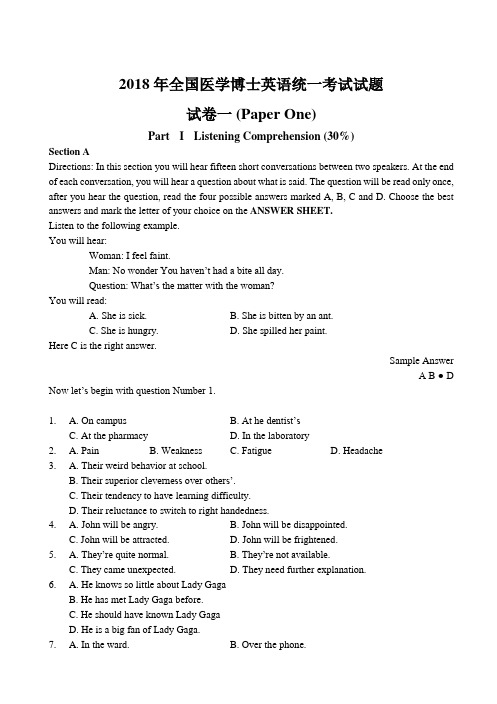
2018 年全国医学博士英语统一考试试题试卷一 (Paper One)Part I Listening Comprehension (30%)Section ADirections: In this section you will hear fifteen short conversations between two speakers. At the end of each conversation, you will hear a question about what is said. The question will be read only once, after you hear the question, read the four possible answers marked A, B, C and D. Choose the best answers and mark the letter of your choice on the ANSWER SHEET.Listen to the following example.You will hear:Woman: I feel faint.Man: No wonder You haven’t had a bite all day.Question: What’s the matter with the woman?You will read:A. She is sick.B. She is bitten by an ant.C. She is hungry.D. She spilled her paint.Here C is the right answer.Sample AnswerA B ● D Now let’s begin with question Number 1.1. A. On campus B. At he dentist’sC.At the pharmacyD. In the laboratory2. A. Pain B. Weakness C. Fatigue D. Headache3. A. Their weird behavior at school.B. Their superior cleverness over others’.C. Their tendency to have learning difficulty.D. Their reluctance to switch to right handedness.4. A. John will be angry. B. John will be disappointed.C. John will be attracted.D. John will be frightened.5. A. Th ey’re quite normal. B. They’re not available.C. They came unexpected.D. They need further explanation.6. A. He knows so little about Lady GagaB. He has met Lady Gaga before.C. He should have known Lady GagaD. He is a big fan of Lady Gaga.C. In the emergency room.D. On their way to the hospital8. A. Health care B. Health reformC. Health educationD. Health maintenance9. A. Learning to act intuitively.B. Learning to argue academically.C. Learning to be critical of oneself.D. Learning to think critically and reason10. A. She is a pharmacist. B. She is a medical doctor.C. She is a scientist in robotics.D. She is a pharmacologist.11. A. She’s pessimistic about the future.B. She’s pessimistic about the far future.C. She’s optimistic about the far future.D. She’s optimistic about the near future.12. A. Negligence may put a patient in danger.B. Patients must listen to doctors and nurses.C. Qualified doctors and nurses are in bad need.D. Patients should be careful about choosing the right hospital.13. A. The man works at eh ER.B. The man can do nothing but wait.C. The woman’s condition is critical.D. The woman is a capable paramedic.14. A. A gynecologist. B. A psychologistC. A neurologist.D. A nephrologist.15. A. She has only one friend.B. She isolates herself from others.C. She suffers from a chronic disease.D. She is jobless and can’t find a job.Section BDirections: In this section you will hear one conversation and two passages, after each of which, you will hear five questions. After each question, read the four possible answers marked A, B, C and D. Choose the best answer and mark the letter of your choice on the ANSWER SHEET.DialogueQuestions 16-20 are based on the following dialogue.16. A. Because she couldn’t do other jobs well.B. Because it was her dream since childhood.C. Because she was fed up with all her previous jobs.D. Because two professors found talent in her and inspired her to do it.17. A. The Self/Nonself Model B. The Danger ModelC. The vaccination theoryD. The immunological theory18. A. Being overactive B. Being mutantC. Being selectiveD. Being resistant19. A. It can help cure most cancers.B. It can help develop new drugs.C. It can help most genetic diseases.D. It can help change the nature of medicine.20. A. We should ignore the resistance.B. We should have the model improved.C. We should have the experiments on animals.D. We should move from animals to human.Passage One21. A. The profits form medical tourism.B.The trendy phenomenon of medical tourism.C.The soaring health care costs around the word.D.The steps to take in developing medical tourism22. A. Affordable costs B. Low pace of livingC. Five-star treatmentD. Enjoyable health vacation23. A. It is a$100 billion business already.B. It is growing along with medical tourism.C. Its costs are skyrocketing with medical tourism.D. It offers more medical options than western medicine.24. A. To set up a website for blogging about medical tourism.B. To modify our lifestyles and health behaviors.C. To buy and affordable medical insurance.D. To explore online to get well informed.25. A. A travel brochure.B. A lecture on medical tourism.C. A chapter of a medical textbook.D. A webpage promotional material.Passage TwoQuestions 26-30 are based on the following passage.26. A. Song sparrows take good care of their babies.B. Young song sparrows back the skills and experience of their parents.C. There are different kind of song sparrows in different seasons.D. Young and old song sparrows experience climate change different.27. A. In the warmer spring B. In the hottest summerC. In the coolest autumnD. In the coldest winter28. A. Because they lack the skill and experience to find food.B. Because they have not developed a strong body yet.C. Because they cannot endure the unusual heat.D. Because they cannot find enough food.29. A. They are less sensitive to the effect of climate change thanks to their parents.B. They are quick to develop strong bodies to encounter climate change.C. They experience food insufficiency due to climate change.D. They are as sensitive to climate change as the juveniles.30. A. Body size B. Migration routeC. Food preferenceD. Population growthPart Ⅱ Vocabulary (10%)Section ADirections: In this section, all the sentences are incomplete. Four words or phrases marked A, B, C and D are given beneath each of them. You are to choose the word or phrase that best completes the sentence, then mark your answer on the ANSWER SHEET.31.The medical team discussed their shared ____to eliminating this curable disease.A.obedienceB. susceptibilityC. inclinationD. dedication32. Many of us are taught from an early age that the grown-up response to pain, weakness, oremotional_____is to ignore it, to tough it out.A. TurmoilB. rebellionC. temptationD. relaxation33. Those depressed kids seem to care little about others,____communication and indulge in theirown worlds.A. put downB. shut downC. settle downD. break down34. The school board attached great emphasis to____ in students a sense of modesty and a sense ofcommunity.A. dilutingB. inspectingC. instillingD. disillusioning35. Our brain is very good at filtering out sensory information that is not______to what we need tobe attending to.A. pertinentB. permanentC. precedentD. prominent36. New studies have found a rather____correlation between the presence of small particles andboth obesity and diabetes.A. collaboratingB. comprehendingC. compromisingD. convincing37. We must test our____about what to include in the emulation and at what level at detail.A. intelligenceB. imitationsC. hypothesisD. precautions.38. We must____the problem____, which is why our map combines both brain structure andfunction measurements at large scale and high resolution.A. set...backB. take...overC. pull...inD. break...down39. Asthma patient doesn’t need continuous treatment because his symptoms are rather____thanpersistent.A. intermittentB. precedentC. dominantD. prevalent40. It is simply a fantastic imagination to_____that one can master a foreign language overnight.A. conceiveB. concealC. convertD. conform Section BDirections: Each of the following sentences has a word or phrase underlined. There are four words or phrases beneath each sentence. Choose the word or phrase which can best keep the meaning of the original sentence if it is substituted for the underlined part. Mark your answer on the ANSWER SHEET.41. The truly competent physician is the one who sits down, senses the “mystery”of anotherhuman beings, and often the simple gifts of personal interest and understanding.A. imaginableB. capableC. sensibleD. humble42. The physician often perceived that treatment was initiated by the patient.A. conservedB. theorizedC. realizedD. persisted43. Large community meals might have served to lubricate social connections and alleviatedtensions.A. facilitateB. intimidateC. terminateD. mediate44. Catalase activity reduced glutathione and Vitamin E levels were decreased exclusively insubjects with active disease.A. definitelyB. trulyC. simplyD. solely45. Ocular anomalies were frequently observed in this cohort of offspring born after in vitrofertilization.A. FetusesB. descendantsC. seedsD. orphans46. Childhood poverty should be regarded as the single greatest public health menace facing ourchildren.A. breachB. griefC. threatD. abuse47. A distant dream would be to deliberately set off quakes to release tectonic stress in a controlledway.A. definitelyB. desperatelyC. intentionallyD. identically48. Big challenges still await companies converting carbon dioxide to petrol.A. applyingB. relatingC. relayingD. transforming49. Concern have recently been voiced that the drugs elicit unexpected cognitive side effects, suchas memory loss, fuzzy thinking and learning difficulties.A. ensueB. encounterC. impedeD. induce50. A leaf before the eye shuts out Mount Tai, which means having one’s view of the importantovershadowed by the trivial.A. insignificantB. insufficientC. substantialD. unexpectedPart ⅢCloze (10%)Directions: In this section there is a passage with ten numbered blanks. For each blank, there are four choices marked A, B, C and D on the right side. Choose the best answer and mark the letter of yourchoice on the ANSWER SHEIET.The same benefits and drawbacks are found when using CT scanning to detect lung cancer—the three-dimensional imaging, improve detection of disease but creates hundreds of images that increase a radiologist’s workload, which, 51 , can result in missed positive scans.Researchers at University of Chicago Pritizker School of Medicine presented 52 data on a CAD (computer-aided diagnosis) program they’ve designed that helps radiologist spot lung cancer 53 CT scanning. Their study was 54 by the NIH and the university.In the study, CAD was applied to 32 low-dose CT scanning with a total of 50 lung nodules, 38 of which were biopsy-confirmed lung cancer that were not found during initial clinical exam. 55 the 38 missed cancers,15 were the result of interpretation error (identifying an image but 56 it as non cancerous) and 23 57 observational error(not identifying the cancerous image).CAD found 32 of the 38 previously missed cancers (84% sensitivity), with false-positive 58 of 1.6 per section.Although CAD improved detection of lung ca ncer, it won’t replace radiologists, said Sgmuel G Armato, PhD, lead author of the study.” The computer is not perfect,”Armato said.” It will miss some cancers and call some things cancer that 59 . The radiologists can identify normal anatomy that the computer may 60 something suspicious. It’s a spell-checker of sorts, or a second opinion.51.A. in common B. in turn C. in one D. in all52.A. preliminary B. considerate C. deliberate D. ordinary53.A. being used B. to use C. using D. use54.A. investigated B. originated C. founded D. funded55.A. From B. Amid C. Of D. In56.A. disseminating B. degenerating C. dismissing D. deceiving57.A. were mistaken for B. were attributed to C. result in D. gave away to58.A. mortalities B. incidences C. images D. rates59.A. don’t B. won’t C. aren’t D. wasn’t60.A. stand for B. search for C. account for D. mistake forPart Ⅳ Reading Comprehension (30%)Directions: In this part there are six passages, each of which is followed by five questions. For each question there are four possible answers marked A, B, C and D. Choose the best answer and mark the letter of your choice on the ANSWER SHEET.Passage OneWhen Tony Wagner, the Harvard education specialist, describes his job today, he says he’s“a translator between two hostile tribes”—the education world and the business world, the people who teach our kids and the people who give them jobs. Wagner’s ar gument in his book “Creating Innovations: The Making of Young People Who Wil l Change the World” is that our K-12 and college tracks are not consistently “adding the value and teaching the skills that matter most in themarketplace.”This is dangerous at a time when there is increasingly to such things as a high-wage, middle-skilled job—the thing that sustained the middle class in the last generation. Now, there is only a high-wage, high-skilled job. Every middle-class job today is being pulled up, out or down faster than ever. That is, it either requires more skill or can be done by more people around the world or is being buried made obsolete faster than ever. Which is why the goal of education today, argues Wagner, should not be to make every child “college ready” but “innovation ready”—ready to add value to whatever they do.That is a tall task. I tracked Wagner down and asked him to elaborate. “Today,” he said via e-mail,” because knowledge is available on every Internet-connected device, what you know matters far less than what you can do with what you know. The capacity to innovate—the ability to solve problems creatively or bring new possibilities to life and skills like critical thinking,communication and collaboration are far more important than acade mic knowledge. As one executive told me, “We can teach new hires the content. And we will have to because it continues to change, but we can’t teach them how to think—to ask the right questions—and to take initiative.”My generation had it easy. We got to “find” a job. But, more than ever, our kids will have to “invent” a job. Sure, the lucky ones will find their first job, but, given the pace of change today, even they will have to reinvent, re-engineer and reimagine that job much often than their parents if they want to advance in it.“Finland is one of the most innovative economics in the world,”Wagner said,” and it is the only country where students leave high school ‘innovation-ready.’ They lea rn concepts and creativity more than facts, and have a choice of many elective—all with a shorter school day, little homework, and almost no testing. There are a growing number of “reinvented”colleges like the Olin College of Engineering, the M.I.T. Media L ab and the “D-school” Stanford where students learn to innovate.”61.In his book, Wagner argues that _____.A.the education world is hostile to our kidsB.the business world is hostile to those seeking jobsC.the business world is too demanding on the education worldD.the education world should teach what the marketplace demands62. What does the “tall task” refer to in the third paragraph?A. Sustaining the middle class.B. Saving high-wage, middle-skilled jobs.C. Shifting from “college ready” in “innovation ready.”D. Preventing middle-class jobs from becoming obsolete fast.63. What is mainly expressed in Wagner’s e-mail?A. New hires should be taught the content rather than the ways of thinking.B. Knowledge is more readily available on Internet-connected devices.C. Academic knowledge is still the most important to teach.D. Creativity and skills matter more than knowledge.64. What is implied in the fourth paragraph?A. Jobs favor the lucky ones in every generation.B. Jobs changed slowly in the autho r’s generation.C. The author’s generation led an easier life than their kids.D. It was easy for the author’s generation to find their first job.65. What is the purpose of the last paragraph?A. to orient future educationB. to exemplify the necessary shift in educationC. to draw a conclusion about the shift in educationD. to criticize some colleges for their practices in educationPassage TwoBy the end of this century, the average world temperature is expected to increase between one and four degrees, with widespread effects on rainfall, sea levels and animal habitats. But in the Arctic, where the effects of climate change are most intense, the rise in temperature could be twice as much.Understanding how Arctic warming will affect the people, animals, plant and marine life and economic activity in Canada’s North are important to the country’s future, says Kent Moore, and atmospheric physicist at University of Toronto Mississauga who is participating in a long-term, international study of the marine ecosystem along the Beaufort Sea, from Alaska to the Mackenzie delta.The study will add to our knowledge of everything from the extent of sea ice in the region to how fish stocks will change to which areas could become targets for oil and gas exploration to the impact on the indigenous people who call this part of the country home.Moore, who has worked in the Arctic for more than 20 years, says his research has already found that thinning sea ice and changes in wind patterns are causing an important change in the marine food chain: phytoplankton(浮游植物)is blooming two to three weeks earlier. Many animals time their annual migration to the Arctic for when food is plentiful, and have not adapted to the earlier bloom. “Animal behavio r can evolve over a long time, but these climate changes are happening in the space of a decade, rather than hundreds of years,” says Moore,“Animals can’t change their behavior that quickly.”A warmer Arctic is expected to have important effects on human activity in the region, as the Northwest Passage becomes navigable during the summer, and resource extraction becomes more feasible. Information gained from the study will help government, industry and communities make decisions about resource management, economic development and environmental protection.Moore says the study—which involves Canadian, American and European researchers and government agencies—will also use a novel technology to gather atmospheric data: remotely piloted drones. “The drones have the capability of a large research aircraft, and they’re easier to deploy,” he says, showing the researchers to gather information on a more regular basis than they would be able to with piloted aircraft.66. By the end of this century, according to the author, global warming will_____.A. start to bring about extreme weather events to humans and animalsB. increase the average world temperature by four degreesC. cause more damages to the whole world than expectedD. affect the Arctic more than any other parts of the earth67. To help understand the destructive mechanism of Arctic warming, as indicated by the passage,the international study ____.A. is conducted with every single discipline of University of TorontoB. pioneers in pursuing the widespread effects of climate change.C. involves so many countries for different investigationsD. is intended to deal with various aspects in research68. When he says, “Animals can’t change their behavior that quickly,” what does Moore mean bythat quick?A. The migration of the animals to the Arctic.B. The widespread effects of global warming.C. The rate of the climate change in the Arctic.D. The phytoplankton within the marine ecosystem.69. According to the author, to carry out proper human activities in the Arctic_____.A. becomes more difficult than ever before.B. is likely to build a novel economy in the region.C. will surely lower the average world temperature.D. needs the research-based supporting information.70. With the drones deployed, as Moore predicts, the researchers will_____.A. involve more collaborating countries than they do now.B. get more data to be required for their research.C. use more novel technologies in research.D. conduct their research at a regular basis.Passage ThreeSkilled clinical history-taking and physical examination remain essential as the basis of the disease diagnosis and management, aided by investigations such as radiological or biochemical tests. Technological advances over the past few decades mean that such investigations now can be refined, or even replaced in some cases, by the measurement of genetic or genomic biomarkers. The molecular characteristics of a disorder or the genetic make-up of an individual can fine tune a diagnosis and inform its management. These new capabilities, often termed “stratified(分层的)” or “personalized” medicine, are likely to have profound effect on the practice of medicine and service delivery.Genetic medicine, which uses genetic or genomic biomarkers in this way, has, until recently, been the province of a small minority of specialized physicians who have used it to diagnose or assess risk of inherited disease. Recognition that most disease has a genetic component, the development and application of new genetic tests to identify important disease subsets and the availability of cost-effective interventions mean that genetic medicine must be integrated more widely across healthcare services. In order to optimize benefit equitably across the population, physicians and services need to be ready to change and adapt to new ways of working.Perhaps the greatest challenge is to ensure the readiness of physicians to use these genomic technologies for maximum effect, so that genetic medicine is incorporated into mainstream specialties. For some clinicians, particularly those involved in clinical research, these advances are already a reality.However, a sizable majority do not yet recognize the relevance of genetics for their clinical practice, perceiving genetic conditions to be rare and untreatable. Maximizing genomic opportunities also means being aware of their limitations, media portrayals that indicate that genetic information gives clear-cut answers are often unrealistic. Indeed, knowing one’s entire genomic seq uence is no the crystal ball of our future that many hope it to be,and physicians will need to be more familiar with what is hype(鼓吹)and what is reality for the integration of genetics into mainstream medicine to be successful.Finally, both professional and public should have a realistic view of what is possible. Although the discovery of genetic risk factors in common diseases such as heart disease and cancer has led to important insights about disease mechanisms, the predictive power of individual genetic variants is often very low. Developments in bioinformatics will need to evolve considerably before the identification of a particular combination of genetic variants in an individual will have clinical utility for them.71.Which of the following statements does the author most probably agree with?A.Personalized medicine will greatly change the practice of medicine.B.Genetic biomarkers have been largely refined over the past.C.Physical examination remains essential in tine tuning a diagnosis.D.Clinical history-taking is no longer important in the genetic era.72.What, according to the second paragraph, can be said of genetic medicine?A. It can offer solutions to all inherited diseases.B. It has been widely recognized among the physicians.C. It necessitates adaptation of the healthcare community.D. It is monopolized by a small minority of specialized physicians.73. The future of the genomic technologies, for the most part, lies in_____.A. the greater potential of treating rare diseasesB. the greater efforts in the relevant clinical researchC. the greater preparedness of the physicians to employ themD. the greater publicity of their benefits in the media portrayals74. In the last paragraph, the author cautions against_____.A. underestimation of the importance of the genetic risk factorsB. unrealistic expectation of the genetic predicative powerC. abuse of genetic medicine in treating common diseasesD. unexpected evolution of the bioinformatics.75. Which of the following can best summarize the main idea of the passage?A. Genetic medicine should be the mainstream option for physicians.B. Genetic medicine poses great challenges to medical practice.C. Genetic medicine will exert great influence on medicine.D. Genetic medicine is defined as “stratified” medicine.Passage FourMisconduct is a word that is always on professors’ minds. Incidents in the news tend to describe the most serious violations of scientific standards, such as plagiarism for fabricating data. But these high-profile infractions(违法)occur relatively rarely. Much more frequent are forms of misconduct that occur as part of the intimate relationship between a faculty member and a student.Faculty members don’t need to commit egregious acts such as sexual harass ment or appropriation of students’work to fail in their responsibility to their charges. Being generally negligent as teachers and mentors should also be seen as falling down on the job.What we found most interesting was how respondents had less vehement(强烈的)reactions to a host of questionable behaviors. In particular, they said that faculty members should avoid neglectful teaching and mentoring. These included routinely being late for classes, frequently skipping appointments with advisees, showing favoritism to some students, ignoring those whose interests diverged from their own, belittling colleagues in front of students, providing little or no feedback on students’ theses or dissertations, and take on more graduate advisees than they could handle.The vast majority of US faculty members have simply not been taught how to teach. And these responses suggest that they are subjecting young scientists-in-training to the same neglect.To address this systemic issue, we must do a better job of exposing the current and next generations of scientists to the rules of proper mentoring through seminars. For instance, on online modules. The societies of academic disciplines, institutions and individual departments can play a big part here, by developing codes of conduct and clear mechanisms for students report violations.The most serious behaviors are relatively easy to spot and address, but “inadequate teaching”can be subjective. Still, if universities establish specific rules for academics to follow, real patterns of abuse will be easier to find. For instance, these rules could stipulate that professors must return substantive feedback on drafts within 15 days, provide more than just negative feedback during a student’s oral defense of their thesis, or be availa ble regularly to answer questions.To deal with faculty members who consistently fall short, universities should establish teaching-integrity committees, similar to the research-integrity committees that handle issues of scientific misconduct. These could receive reports from students and decide what action to take, either by following a due process laid out in the faculty manual, or simply by adopting the same process as that of other committees, such as for tenure applications.76.What is implied in the first two paragraphs?A. The misconducts are widely exposed in the news.。
2018年临床医学综合能力(中医)真题.doc
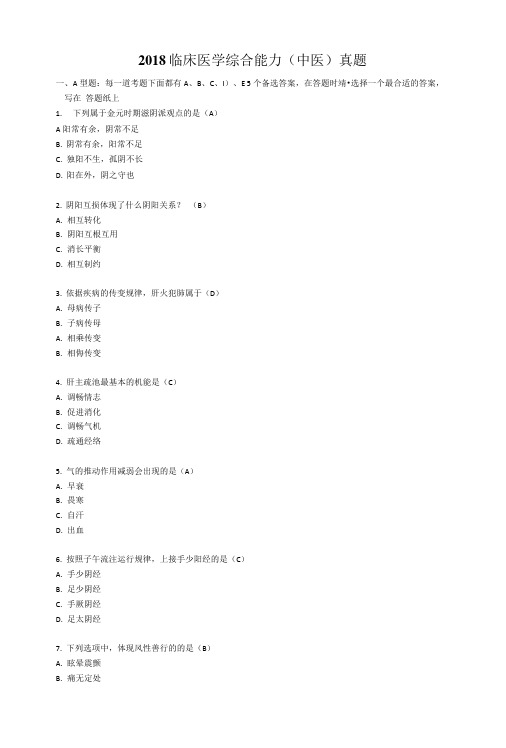
2018临床医学综合能力(中医)真题一、A型题:每一道考题下面都有A、B、C、I)、E 5个备选答案,在答题时靖•选择一个最合适的答案,写在答题纸上1.下列属于金元时期滋阴派观点的是(A)A阳常有余,阴常不足B.阴常有余,阳常不足C.独阳不生,孤阴不长D.阳在外,阴之守也2.阴阳互损体现了什么阴阳关系?(B)A.相互转化B.阴阳互根互用C.消长平衡D.相互制约3.依据疾病的传变规律,肝火犯肺属于(D)A.母病传子B.子病传母A.相乘传变B.相侮传变4.肝主疏池最基本的机能是(C)A.调畅情志B.促进消化C.调畅气机D.疏通经络5.气的推动作用减弱会出现的是(A)A.早衰B.畏寒C.自汗D.出血6.按照子午流注运行规律,上接手少阳经的是(C)A.手少阴经B.足少阴经C.手厥阴经D.足太阴经7.下列选项中,体现风性善行的的是(B)A.眩晕震颤B.痛无定处C.手足抽搐D.角弓反张8.五气过极与六郁气滞均可•化生(D)[单选题]A.痰浊B.湿热C.燥热D.内火9.“见肝之病,知肝传脾,当先实脾〃出白(B)[单选题]A.《内经》B.《难经》C.《中藏经》D.《伤寒论》10.症见表情淡漠,反应迟钝,呼吸微弱者,属于(D)[单选题]A.假神B.神乱C.少神D.失神11.濡脉和弱脉的共同特征是(A)[单选题]A.脉形细脉势软B.脉位沉脉势软C.脉位沉脉形细D.脉形细脉率快12.以下选项中,属于斑秃常见原因的是(D)[193003600]A.气阴两虚B.气血两虚C.血燥化热D.血虚受风13.患者心烦失眠,面红门渴,小便短黄,舌红苔黄,脉数,辨证为(C)[单选题]A.肝阳上亢证B.肝火上炎证C.心火亢盛证D.心阴虚证14.脉弦细数的证是(B)[单选题]A.肝火上炎B.肝肾阴虚C.血虚肝郁D.肝郁气滞15.证见胸闷息促,肋间饱淌,咳唾引痛,苔白滑,脉弦者,应诊断为(B)[单选题]A.痰饮B.悬饮C.溢饮D.支饮16.症见胸中烦热,咽痛口干,腹痛喜暖,大便澹薄,属于(B)[单选题]A.表寒里热B.上热下寒C.其寒假热D.热症转寒17.症见肮腹,腰膝冷痛,五更泄泻,倦怠食少,舌淡嫩,苔白腻,脉弱辨证为(C)[单选题]A.肾阳虚B.脾阳虚C.脾肾阳虚D.肾气不固18.症见高热,大汗,□渴喜冷饮者,宜诊断为(B)[单选题]A.太阳经证B.阳明经证C.阳明腑实证D.少阳热化证19.下列药物中,孕妇宜慎用的是(A)[单选题]A.蝉蜕B.桑叶C.菊花D.蔓荆子20.外用可引起皮肤发红.灼热.起泡.甚至腐烂,故不宜久敷的药物是(C)[单选题]A.硫黄B.白矶C.斑螯D.硼砂21.治疗麻风,疥癣宜选用的药物是:(B)[单选题]A.木瓜B.乌梢蛇CJII乌D.威灵仙22.篇蓄、地肤子的共同功效(D)[单选题]和血止痛 理气止痛 醒脾开胃 燥湿化痰A. 利尿通淋,止泻B. 利尿通淋,止咳C. 利尿通淋,止血D. 利尿通淋,止痒23. 玫瑰花的功效是(A )[单选题] A. 疏肝解郁, B. 疏肝解郁, C. 理气和中, D. 理气健脾,24. 内服宜炒去汕,胃弱者慎用的药物是(D )[单选题]A. 穿山甲B. 自然铜C. 土鳖虫D. 没药25. 下列可用酸枣仁而不能用柏子仁的是(B )[单选题]A. 润肠通便B. 津伤门渴C. 心神不宁D. 血虚身痛26. 芫花内服入煎剂的剂量(C )[单选题]A 03-0.5gB 0.5-lgC 1.5-3gD6-9g27. 清热解毒宜生用,止血宜炒炭用的是(B )[单选题]A. 青黛B. 贯众C. 土茯苓D. 漏芦28. 大黄牡丹汤和桃仁承气汤组成相同的药物上是(D )[单选题]A. 大黄,丹皮B. 桃仁,丹皮C. 大黄,枳实D. 大黄,桃仁29.葛根.前胡.桔梗同用的方剂(A)[单选题]A.参苏饮B.杏苏散C.败毒散D.柴葛解肌汤30.牛莠解肌汤的功效(C)[单选题]A.疏风清热解毒透诊B.疏散外邪发表解肌C.疏风清热凉血消肿D.疏风散邪,清热解毒31.具有养血安神,清热除烦的方剂(B)[单选题]A.归脾汤B.酸枣仁汤C.珍珠母丸D.天王补心丹32.患者大便秘结,小便清长,头目眩晕,腰膝酸软,舌淡苔白,脉沉退,治宜选用(C)[单选题]A.温脾汤B.肾气丸C.济川煎D.大黄附子汤33.患者大热渴饮,吐岫发斑,四肢抽搐,舌绛唇焦,脉沉数,治用(D)[单选题]A.白虎加人参汤B.犀角地黄汤C.黄连解毒汤D.消瘟败毒饮34.体现风痰并治.标本兼顾的方剂(B)[单选题]A.天麻钩藤饮B.半夏白术天麻汤C.消气化痰丸D.三子养亲汤35.苓桂术甘汤和五苓散中,配伍桂枝的相同点(C)[单选题]A.解肌发表B.平冲降逆C.温阳化气D.温通经脉36应用六味地黄丸治疗阴虚火旺应该加配的药物是(D)[单选题]A.枸杞子,菊花B.五味子,麦冬C.黄连,阿胶D.知母,黄柏37.患者,男,64岁,大量饮酒后出现吞咽梗阻,进食后胸肮满闷,呕吐痰涎,门干咽燥,舌红苔薄腻,脉弦滑,治疗宜选用(C)【单选题]A.疏肝解郁,和胃消痞B.健脾和中,理气化痰C.开郁化痰,润燥降气D.理气和胃,降逆止呕38.患者,女,43岁,胁肋胀痛反复发作,进食油腻食物加重,半年前黄疸,手术后黄疸消退。
历年考博真题
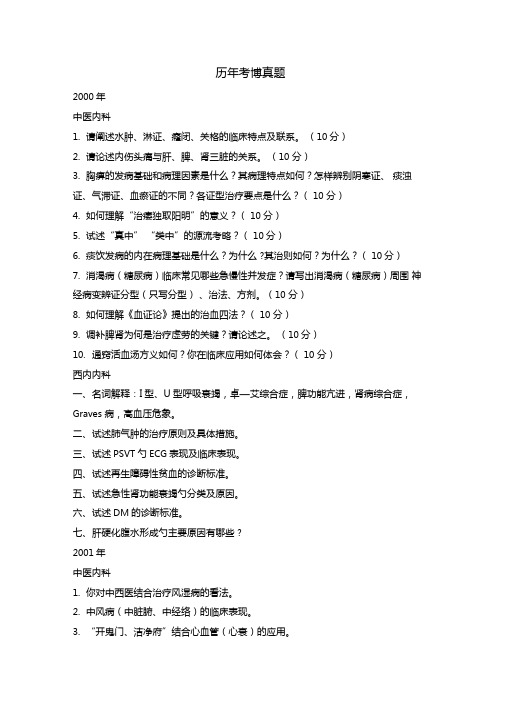
8.AS与RA鉴别要点
9.早期胃癌定义、分型
10.门脉高压临床表现?发生机制?
2005年
中医内科
一、名词解释:雷头风、呃逆、寒热往来、疟疾
二、心动悸、脉结代、动态心电图示阵发性室颤,请写出可能出现的中医证型, 治方药。可使用哪些抗心率失常的中药。
三、脉痹的临床表现
四、张仲景关于水肿治疗原则是什么,见于何书,结合临床谈谈你的体会
1.胃癌前病变和疾病有哪些?
2.肺心病加重期的治疗
3.脑血管疾病可干预的危险因素有哪些?4.导致全血细胞下降的疾病有哪些?
5.DM肾病分期
6.溃疡性结肠炎的临床分型
7.引起肺栓塞的疾病有哪些?
8.gout的治疗原则。
9.舒张性心力衰竭如何治疗
10.急性胰腺炎的体征有哪些?当跟哪些疾病鉴别
3.久泄之治法,如何健脾、运脾?
4.白塞病之经典论述,相当于?主要方剂
5.三承气汤之方义、应用、区别
6.理虚元鉴提出的治虚劳之本,如何理解
7.瘿病相当于?病变过程中之病机转化?
8.血管性痴呆的病因、病机
9.六郁的证候特征
10.因虚致痛如何理解
西医内科
1.糖尿病酮症酸中毒(DKA之治则
2.狼疮肾之病理分型,活动性指标
3.周围性眩晕和中枢性眩晕的鉴别
4.慢性房颤的分型和治疗
5.乙肝抗病毒治疗
6.肾综合并急肾衰的原因
7.腰穿之适应证、禁忌症
8.肺心病中肺A高压的形成机制
9.根据红细胞的形态,贫血的病因和发病机理,贫血分类(2种分类)
10.DIC之诊断标准
2008年
中医内科
1.论述“治未病”思想在肿瘤临床的应用。
近5年 中医基础理论考博真题

2016—2020年中医基础理论考博真题上海中医药大学中医基础理论2019年考博真题试卷名词解释(5题,每题4分,共20分)1.土爱稼穑2,阴病治阳3.审证求因4.湿性黏滞5.塞因塞用论述题(5题,每题8分,共40 分)1.营气与卫气有何异同,营卫失和的临床表现2.水湿痰饮的区别与联系3.何为十二经脉的表里关系?其特点与其意义如何?4.外燥与内燥的异同5.脾与精,气,血,津液的生理联系湖南中医药大学2018年攻读博士学位研究生入学考试考试科目:中医基础理论注意:所有答案-律写在答题纸上。
写在试题纸上或其他地方--律不给分。
、名词解释1.肝主疏泄2.肺主治节3.循经取穴4. 内生五邪5.塞因塞用6.阴病治阳7.精血同源8. 心肾不交二、简答题1. 脾胃的关系。
2. 饮的分类。
3. 药邪的形成及致病特点。
4.风邪致病的特点。
5.心主神明与脑主神明的认识。
6. 三焦的认识。
7.脏腑之别。
山东中医药大学中医基础理论2018年考博真题考试科目:中医基础理论注意:所有答案-律写在答题纸上,写在试题纸上或其他地方一-律不给分。
论述题: .1.试述心与肾的关系。
2.《内经》中津液的产生与输布。
3.如何理解冲为血海。
4.火热内生的临床表现及致病因素。
5.体质的概念及形成因素。
6.如何理解大实有赢状,至虚有盛候。
7.试述”阴病治阳,阳病治阴”与”阴中求阳,阳中求阴”有何异同?8.试述湿邪致病特点,及与外湿有何异同?9.谈谈对益火补土法的认识及临床中的应用。
山东中医药大学中医基础理论考博真题1.风邪性质和致病特征,为什么说风为百病之长?2.从病机转化角度说明寒证转化为热证的转变形式?3.虚实的病机机制?2018年山东中医药大学博士考试中医基础理论试题1.试述心与肾的关系。
2.《内经》中津液的产生与输布。
3.如何理解冲为血海。
4.火热内生的临床表现及致病因素。
5.体质的概念及形成因素。
6.如何理解大实有羸状,至虚有盛候。
中医考博试题.doc

中医文献学2005年1何谓文献学?屮医文献学的基础知识包括哪些方而?2金元时期中医学术发展的特点是什么?试述此期的主要医家和医著。
3请问汉刘歆的《七略》中提出的六略分类法是哪六略,其中医经、经方等书籍分在哪一略?4请简述校勘与校觥的关系。
5请简述古籍的丿力代版本类别。
6伪书的形成主要有哪些因素?如何辨析和利用伪书?7宋代校正医书局的主要成员冇哪几位?在中医古籍整理方面有何成就?(举出5例)8中医文献研究中选择善本有何重要意义?9请简述《伤寒杂病论》传本系统。
10试述中医文献研究对于当代中医临床研究的意义和作用。
2006年1何谓文献?简述我国古代文献载体。
2类书与丛书有何区别?各举出三部较著名的中医类书和丛书。
3简述六朝至隋唐时期医药文献发展的特点和代表作品。
4简述避讳的概念、避讳方法并举例说明研究避讳对中医占籍的校勘与利用的意义。
5校勘的主要方法有几种?请简述之。
6请简述点校说明与校勘的概念,并说明两者的区别?7请简述训诂(注释)的基本方法。
8请简述占代书目的基木结构。
9请简述四部分类法,其中“医学类”书籍分在哪一部?10请结合您所从事的研究,谈谈对屮医文献学的认识。
2007年1简述胡适捉出辨别伪书的五种方法。
2我国占代解题课分为几类,请分别进行简述。
3从哪几个方而进行版本鉴别,请试述Z。
4请简述校勘的方式。
5什么是因声求意。
请试述之。
6以《古今图书集成医部全录》为例,分析中医类书的常见体例。
7《黄帝内经》冇哪几个主要传本系统、请简述Z。
8陈垣先生总结占籍校勘“四校法”的主要内容是什么?9六朝至隋唐时期医药文献发展的特点是什么?冇哪些代表作品?10屮国古代书口的基木结构和特点是什么?2008年1什么是类书、丛书?以屮医书籍为例说明二者的特点。
2什么是“比较互证”,其方式主要有哪些?3评判辑佚书优劣的标准是什么?4胡适在《屮国哲学史大纲》对辨别伪书如何认识的?5试述《晋中经簿》一书对目录学分类方法的影响。
考博中医真题
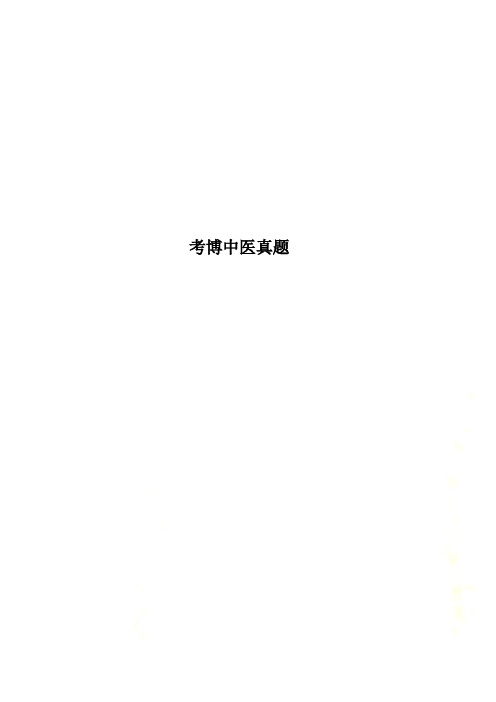
考博中医真题上海中医药大学2016年博士入学考试中医内科学(基础篇,代码2010)真题回忆一,名词解释:1,木曰曲直;2,五行胜复;3,血虚生风;4,阴脉之海;5,津血同源;二,填空:1,宗气功能()()();2,益火之源以消阴翳用于治疗()症,内经称其();3,五脏的共同生理特点是();4,两胁疼痛多是()疾病,缺盆中痛常是()病;5,()和()既是病理产物,又是致病因素。
三,多选:四,简答题:1,营、卫二气的异同;2,冲脉与女子月经、孕育有何联系?3,何谓“燥易伤肺”?4,胆为何既为六腑之一,又属奇恒之腑?5,痰饮的形成;6,中医治则中“标”、“本”的含义?五,问答题:1,“津血同源”、“血汗同源”二者如何理解?有何临床意义?2,督脉循行,功能;3,阴阳平和质、偏阳质、偏阴质,三种体质的特点;4,从生理、病理如何理解“肾主二便”?中国中医科学院中医基础理论A卷填空2*10中医的两个特点管子·乘马:春夏秋冬,阴阳之推移也心的生理功能胆的生理功能足三阴走行肝在体合筋,开窍于目阴阳体质最早见于灵枢·通天实证问答10*4 300字心为君主之官十二经脉交接血的生理功能肺的病机思考10*1 500字中医病机和症候和现代研究的例子和看法中国中医科学院中医内科学A卷名解2*10悬饮关格瘴疟内生五气时行感冒疫毒痢厥证痿证颤证简述5*8痹证的病理变化疟疾治疗原则痢疾的治疗禁忌疫毒痢疾的治法方药眩晕痰湿中阻治法方药消渴的并发症反胃和呕吐鉴别积聚鉴别病例20*1心悸痰热扰心论述20*1肺脾肾在虚劳治疗的作用2016年北京中医药大学伤寒专业中医内科学考博真题一,名解20分:时行感冒,热淋,休息痢,忘记了一个。
二,问答题:1.从肝论治肺系疾病,举出3个病症。
2.归脾汤运用于哪些内科疾病,举出3个病症的主症特点。
三,病例分析20分:胃痞肝郁气滞证。
2016辽宁中医药大学中医基础理论中基:一、简答1.何为五神,说说五神与五脏的关系2.3.二论述一个13分1.心主血脉2.津液代谢与那些脏腑相关中诊一、填空1五轮学说,黑睛属肾为水轮,,,,,(白睛属肺),为气轮2,<古书>曰:(),俗称上热下寒喉痹,,,,,3,,,,,高出皮肤,扶之碍手,为(),4. 小儿指纹直达指端,称为(透关射甲),病情危重,,,名词:假神;气不摄血;解颅;还有2个想不起来了二。
中国中医科学院病理生理学2018--2019年考博真题
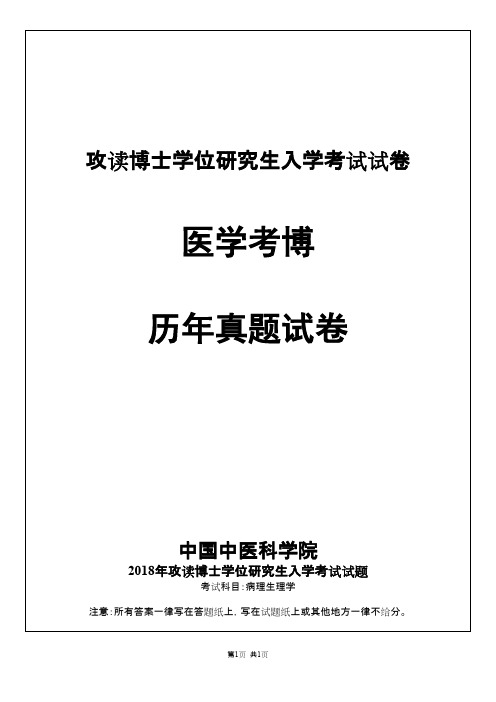
医学考博 历年真题试卷
中国中医科学院
2018年攻读博士学位研究生入学考试试题
考试科目:病理生理学 注意:所有答案一律写在答题纸上,写在试题纸上或其他地方一律不给分。
第1页 共1页
一、名词解释 1. 发热 2. 组织性缺氧 3. 黑伯反射 4. 良性应激 5. 前负荷
二、问答题 1. 蛋白质修饰主要有哪几种形式 2. 细胞凋亡 3. 内分泌系统的调节方式 4. 缺氧类型及机制, 5. 高钾血症、缺血再注机制 6. 大量饮清水尿量变化
第1页 共1页
中国中医科学院
2019年攻读博士学位研究生入学考试试题
考试科目:病理生理学 注意:所有答案一律写在答题纸上,写在试题纸上或其他地方一律不给分。
第1页 共1页
一、名词解释 1. 细胞凋亡 2. 酮症酸中毒 3. 脱水 4. DIC 5. 动脉粥样硬化 6. 血氧分压 7. 低钾血症 8. 失语 二、简述题 脂蛋白血症遗传因素 3. 低渗性脱水的概述和原因 4. 右心衰导致水肿的机制 5. 腹水的发生机制 三、论述题 1. 调控细胞周期对癌症的防治
2018年执业药师中药学综合考试真题.doc

2018年执业药师《中药学综合知识与技能》考试真题一、单项选择题1.根据中医理论,“症”“证”“病”含义不同,下列表述中属于“证”的是()。
A.胸痹B.心悸C.气虚血瘀D.胸肋胀满E.胸痛彻背【答案】C2.根据阴阳理论,下列属阳的是()。
A.滋润B.兴奋C.抑制D.凝聚E.收敛【答案】B3.具有助心行血作用的气成是()。
A.营气B.宗气C.卫气D.元气E.真气【答案】B4.称为“十二经脉之海”的静脉是()。
A.带脉B.督脉C.任脉D.冲脉E.阴维脉【答案】D5.某女,22岁,身体偏寒,喜脉,少动,其体质类型应辩为()。
A.偏阳质B.气虚质C.偏阴质D.痰湿质E.淤血质【答案】C6.根据七情内伤治病的理论,惊可导致()。
A.气上B.气结C.气消E.气乱【答案】E7.中医诊断用以分辨疾病性质的纲领是()。
A.阴阳B.表里C.寒热D.虚实E.气血【答案】C8.执业药师在审方中发现有中成药不合理配伍,下列各组配伍中,属证候禁忌的是()。
A.二陈丸与平胃丸B.归脾丸与养荣丸C.金匮肾气丸与麦味地黄丸D.附子理中丸与黄连上清丸E.生脉饮与六味地黄丸【答案】D9.某男,39岁,肛内肿物脱出,肛管紧缩,坠胀疼痛,触痛明显,舌质暗红,苔薄白,脉细涩,中医辨证为内痔气滞血瘀证,治宜选用的方剂是()。
A.止痛如神汤B.凉血地黄汤C.补中益气汤D.桃仁承气汤E.四妙勇安汤【答案】A10.某男,25岁,因腹泻就诊。
症见腹痛肠鸣,泻下粪便臭如败卵,伴有未消化食物,泻后痛喊,喛腐吞酸,不思饮食,舌苔厚腻,脉滑,治宜选用的方剂是()。
A.保和丸B.参苓白术散C.四神丸D.葛根苓连汤E.藿香正气散【答案】A11.安排饮片斗谱时,不能排于一斗或上下药斗中的是()。
A.麻黄与桂皮B.陈皮与青皮C.酸枣仁与远志D.乌头与天花粉E.板蓝根与大青叶【答案】D12.中药养护中西湿防潮法可采用的干燥剂是()。
A.干冰B.生石灰C.熟石灰E.氢氧化钙【答案】B13.罂粟壳中毒的典型症状是()。
2018中医执业医师实践考试真题汇总 第二站
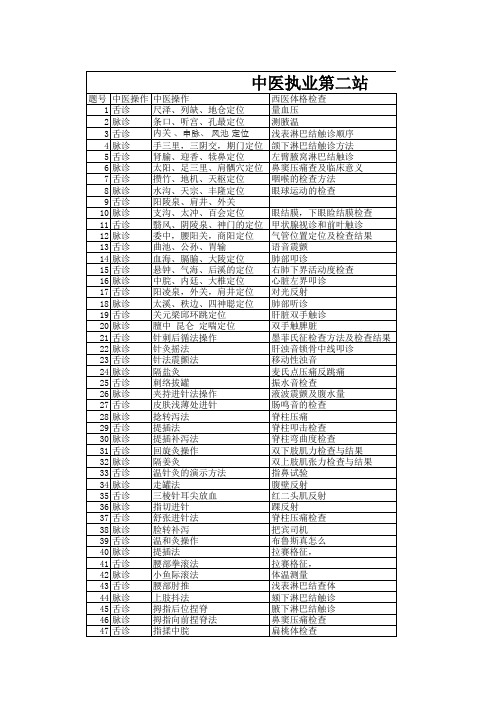
题号 1 2 3 4 5 6 7 8 9 10 11 12 13 14 15 16 17 18 19 20 21 22 23 24 25 26 27 28 29 30 31 32 33 34 35 36 37 38 39 40 41 42 43 44 45 46 47 中医操作 舌诊 脉诊 舌诊 脉诊 舌诊 脉诊 舌诊 脉诊 舌诊 脉诊 舌诊 脉诊 舌诊 脉诊 舌诊 脉诊 舌诊 脉诊 舌诊 脉诊 舌诊 脉诊 舌诊 脉诊 舌诊 脉诊 舌诊 脉诊 舌诊 脉诊 舌诊 脉诊 舌诊 脉诊 舌诊 脉诊 舌诊 脉诊 舌诊 脉诊 舌诊 脉诊 舌诊 脉诊 舌诊 脉诊 舌诊 中医操作 尺泽、列缺、地仓定位 条口、听宫、孔最定位 内关 、申脉、 风池 定位 手三里,三阴交,期门定位 肾腧、迎香、犊鼻定位 太阳、足三里、肩髃穴定位 攒竹、地机、天枢定位 水沟、天宗、丰隆定位 阳陵泉、肩井、外关 支沟、太冲、百会定位 翳风、阴陵泉、神门的定位 委中,腰阳关,商阳定位 曲池、公孙、胃输 血海、膈腧、大陵定位 悬钟、气海、后溪的定位 中脘、内廷、大椎定位 阳凌泉,外关,肩井定位 太溪、秩边、四神聪定位 关元梁邱环跳定位 膻中 昆仑 定喘定位 针刺后循法操作 针灸摇法 针法震颤法 隔盐灸 刺络拔罐 夹持进针法操作 皮肤浅薄处进针 捻转泻法 提插法 提插补泻法 回旋灸操作 隔姜灸 温针灸的演示方法 走罐法 三棱针耳尖放血 指切进针 舒张进针法 脸转补泻 温和灸操作 提插法 腰部拳滚法 小鱼际滚法 腰部肘推 上肢抖法 拇指后位捏脊 拇指向前捏脊法 指揉中脘 西医体格检查 量血压 测腋温 浅表淋巴结触诊顺序 颌下淋巴结触诊方法 左臂腋窝淋巴结触诊 鼻窦压痛查及临床意义 咽喉的检查方法 眼球运动的检查 眼结膜,下眼睑结膜检查 甲状腺视诊和前叶触诊 气管位置定位及检查结果 语音震颤 肺部叩诊 右肺下界活动度检查 心脏左界叩诊 对光反射 肺部听诊 肝脏双手触诊 双手触脾脏 墨菲氏征检查方法及检查结果 肝浊音锁骨中线叩诊 移动性浊音 麦氏点压痛反跳痛 振水音检查 液波震颤及腹水量 肠鸣音的检查 脊柱压痛 脊柱叩击检查 脊柱弯曲度检查 双下肢肌力检查与结果 双上肢肌张力检查与结果 指鼻试验 腹壁反射 红二头肌反射 踝反射 脊柱压痛检查 把宾司机 布鲁斯真怎么 拉赛格征, 拉赛格征, 体温测量 浅表淋巴结查体 颏下淋巴结触诊 腋下淋巴结触诊 鼻窦压痛检查 扁桃体检查
2018临床医学综合能力(中医)真题

2018临床医学综合能力(中医)真题一、A型题:每一道考题下面都有A B、C D、E 5个备选答案,在答题时请选择一个最合适的答案,写在答题纸上1.下列属于金元时期滋阴派观点的是(A)A阳常有余,阴常不足B.阴常有余,阳常不足C.独阳不生,孤阴不长D.阳在外,阴之守也2.阴阳互损体现了什么阴阳关系?(B)A.相互转化B.阴阳互根互用C消长平衡D.相互制约3.依据疾病的传变规律,肝火犯肺属于(D)A.母病传子B.子病传母A.相乘传变B.相侮传变4.肝主疏泄最基本的机能是(C)A.调畅情志B.促进消化C调畅气机D.疏通经络5.气的推动作用减弱会出现的是(A)A.早衰B畏寒C.自汗D.出血6.按照子午流注运行规律,上接手少阳经的是(C)A.手少阴经B.足少阴经C手厥阴经7.下列选项中,体现风性善行的的是(B)A.眩晕震颤B.痛无定处C手足抽搐8. 五气过极与六郁气滞均可化生(D )[单选题]A 痰浊B.湿热C 燥热D.内火9. 见肝之病,知肝传脾,当先实脾 ”出自(B )[单选题]A.《内经》B. 《难经》C. 《中藏经》D. 《伤寒论》10.症见表情淡漠,反应迟钝,呼吸微弱者,属于( D )[单选题]A 假神B 神乱C 少神D.失神11.濡脉和弱脉的共同特征是(A )[单选题] A.脉形细12.以下选项中,属于斑秃常见原因的是( D )A.气阴两虚B.气血两虚C 血燥化热D.血虚受风13.患者心烦失眠,面红口渴,小便短黄,舌红苔黄,脉数,辨证为(A.肝阳上亢证B.肝火上炎证C 心火亢盛证D.心阴虚证 14.脉弦细数的证是(B )[单选题]A.肝火上炎B.肝肾阴虚C 血虚肝郁D.肝郁气滞B.脉位沉 脉势软 C 脉位沉 脉形细D.脉形细 脉率快脉势软C )[单选题]22.萹蓄、地肤子的共同功效 (D )[单选题]B.乌梢蛇C 川乌D.威灵仙15.证见胸闷息促,肋间饱满,咳唾引痛,苔白滑,脉弦者,应诊断为 A 痰饮(B ) [单选题]B 悬饮C 溢饮D.支饮16.症见胸中烦热,咽痛口干,腹痛喜暖,大便溏薄,属于( A.表寒里热B )[单选题]B.上热下寒C 真寒假热D.热症转寒17.症见脘腹,腰膝冷痛,五更泄泻,倦怠食少,舌淡嫩,苔白腻,脉弱辨证为(A.肾阳虚C )[单选题]B 脾阳虚C 脾肾阳虚D.肾气不固18.症见高热,大汗,口渴喜冷饮者,宜诊断为( B )[单选题]A.太阳经证B.阳明经证C.阳明腑实证D.少阳热化证19.下列药物中,孕妇宜慎用的是( A.蝉蜕A )[单选题]B 桑叶C 菊花D.蔓荆子20. 193003600外用可引起皮肤发红.灼热.起泡.甚至腐烂,故不宜久敷的药物是(C )[单选题] B.白矶C 斑蝥D 硼砂21.治疗麻风,疥癣宜选用的药物是 A.木瓜:(B )[单选题]A. 利尿通淋,止泻B. 利尿通淋,止咳C 利尿通淋,止血 D.利尿通淋,止痒23.玫瑰花的功效是(A )[单选题]A. 疏肝解郁,B. 疏肝解郁, C 理气和中, D.理气健脾,和血止痛理气止痛醒脾开胃燥湿化痰24.内服宜炒去油,胃弱者慎用的药物是( A.穿山甲 D )[单选题]B. 自然铜C.土鳖虫 D 投药25.下列可用酸枣仁而不能用柏子仁的是( A.润肠通便 B )[单选题]B 津伤口渴C 心神不宁D.血虚身痛26.芫花内服入煎剂的剂量(C )[单选题]A 0.3-0.5gB 0.5-1gC 1.5-3gD 6-9g 27.清热解毒宜生用,止血宜炒炭用的是(A. 青黛B. 贯众B )[单选题]C.土茯苓D 漏芦28.大黄牡丹汤和桃仁承气汤组成相同的药物上是( D )[单选题]A. 大黄,丹皮B. 桃仁,丹皮C 大黄,枳实D.大黄,桃仁29.葛根.前胡.桔梗同用的方剂(A )[单选题]A.参苏饮B.杏苏散C 败毒散D.柴葛解肌汤 30.牛蒡解肌汤的功效(C )[单选题]A. 疏风清热B •酸枣仁汤C 珍珠母丸D 天王补心丹B.肾气丸C 济川煎D.大黄附子汤A.白虎加人参汤B.犀角地黄汤C 黄连解毒汤D.清瘟败毒饮34. 体现风痰并治.标本兼顾的方剂(B )[单选题]A. 天麻钩藤饮B.半夏白术天麻汤C. 清气化痰丸D. 三子养亲汤35. 苓桂术甘汤和五苓散中,配伍桂枝的相同点(A. 解肌发表B. 平冲降逆C 温阳化气D.温通经脉36应用六味地黄丸治疗阴虚火旺应该加配的药物是( D )[单选题]A. 枸杞子,菊花B. 五味子,麦冬C 黄连,阿胶33.患者大热渴饮, 吐衄发斑,四肢抽搐,舌绛唇焦, 脉沉数,治用( D )[单选题]B.疏散外邪 发表解肌C 疏风清热 凉血消肿D.疏风散邪, 清热解毒31.具有养血安神, A.归脾汤清热除烦的方剂(B )[单选题]解毒透诊32.患者大便秘结, A.温脾汤小便清长,头目眩晕,腰膝酸软, 舌淡苔白,脉沉迟,治宜选用(C )[单选题] C )[单选题]D.知母,黄柏 37.患者,男,64岁,大量饮酒后出现吞咽梗阻,进食后胸脘满闷,呕吐痰涎,口干咽燥,舌红苔薄腻,脉 弦滑,治疗宜选用(C )[单选题] A. 疏肝解郁, B. 健脾和中,C. 开郁化痰,D. 理气和胃, 和胃消痞 理气化痰 润燥降气 降逆止呕 38.患者,女,43岁,胁肋胀痛反复发作,进食油腻食物加重,半年前黄疸, 手术后黄疸消退。
2018年中医执业助理医师真题精选及答案解析
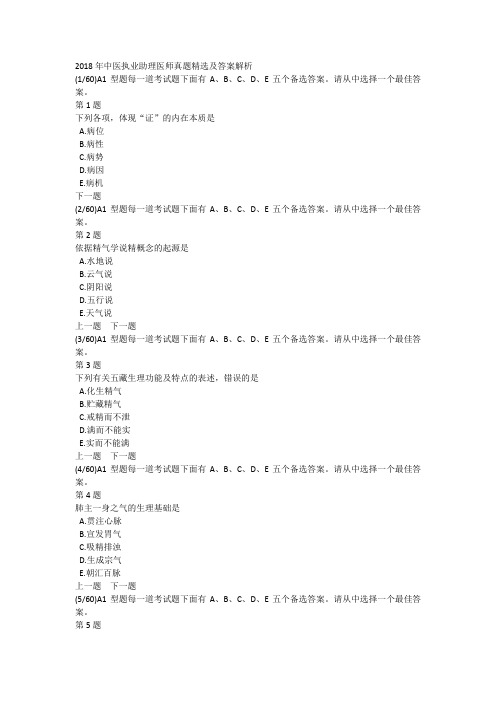
2018年中医执业助理医师真题精选及答案解析(1/60)A1型题每一道考试题下面有A、B、C、D、E五个备选答案。
请从中选择一个最佳答案。
第1题下列各项,体现“证”的内在本质是A.病位B.病性C.病势D.病因E.病机下一题(2/60)A1型题每一道考试题下面有A、B、C、D、E五个备选答案。
请从中选择一个最佳答案。
第2题依据精气学说精概念的起源是A.水地说B.云气说C.阴阳说D.五行说E.天气说上一题下一题(3/60)A1型题每一道考试题下面有A、B、C、D、E五个备选答案。
请从中选择一个最佳答案。
第3题下列有关五藏生理功能及特点的表述,错误的是A.化生精气B.贮藏精气C.戒精而不泄D.满而不能实E.实而不能满上一题下一题(4/60)A1型题每一道考试题下面有A、B、C、D、E五个备选答案。
请从中选择一个最佳答案。
第4题肺主一身之气的生理基础是A.贯注心脉B.宣发胃气C.吸精排浊D.生成宗气E.朝汇百脉上一题下一题(5/60)A1型题每一道考试题下面有A、B、C、D、E五个备选答案。
请从中选择一个最佳答案。
第5题下列各项,其相互关系表现为“精神互用,君相安位”特点的是A.肝和脾B.心和肝C.肝和肾D.心和肾E.脾和肾上一题下一题(6/60)A1型题每一道考试题下面有A、B、C、D、E五个备选答案。
请从中选择一个最佳答案。
第6题其有“汇集水液”生理技能的是A.小肠B.大肠C.膀胱D.三焦E.脾胃上一题下一题(7/60)A1型题每一道考试题下面有A、B、C、D、E五个备选答案。
请从中选择一个最佳答案。
第7题脏与腑的关系中,体现“升降相因”关系的是A.肝与胆B.脾与胃C.肺与大肠D.心与小肠E.肾与膀胱上一题下一题(8/60)A1型题每一道考试题下面有A、B、C、D、E五个备选答案。
请从中选择一个最佳答案。
第8题“夺血者无汗”的理论依据是A.气能摄津B.津血同源C.津能载气D.精血同源E.汗为心液上一题下一题(9/60)A1型题每一道考试题下面有A、B、C、D、E五个备选答案。
2018年全国医学考博英语试题.doc

2018MD全国医学博士外语统一考试英语试卷答题须知1.请考生首先将自己的姓名、所在考点、准考证号在试卷一答题纸和试卷二标准答题卡上认真填写清楚,并按“考场指令”要求,将准考证号在标准答题卡上划好。
2.试卷一(Paper One浴案和13c卷二(Paper Two溶案都作答在标准答题卡上,不要做在试卷上。
3.试卷一答题时必须使用2B 铅笔,将所选答案按要求在相应位置涂黑;如要更正,先用橡皮擦干净。
书面表达一定要用黑色签字笔或钢笔写在标准答题卡上指定区域。
4.标准答题卡不可折叠,同时答题卡须保持平整干净,以利评分。
5.听力考试只放一遍录音,每道题后有15秒左右的答题时间。
国家医学考试中心PAPER ONEPart 1 : Listening comprehension (30%)Section ADirections: In this section you will hear fifteen short conversations between two speakers, At the end of each conversation, you will hear a question aboutwhat is said, The question will be read only once, After you hear thequestion, read the four possible answers marked A, B, C, and D. Choose thebest answers and mark the letter of your choice on the ANSWER SHEET .Listen to the following exampleYou will hearWoman: I feel faint.Man: No wonder. You haven ' t had a bite all day.Question: What' s the matter with the woman?You will read:A.She is sick.B.She was bitten by an ant.C.She is hungry.D.She spilled her paint.Here C is the right answer.Sample AnswerA B C DNow let ' s begin with question Number 1.1. A. About 12 pints B. About 3 pintsC. About 4 pintsD. About 7 pints2. A. Take a holiday from work. B. Worry less about work.C. Take some sleeping pills.D. Work harder to forget all her troubles.3. A. He has no complaints about the doctor.B.He won't complain anything.C.He is in good condition.D.He couldn't be worse.4. A. She is kidding.B.She will get a raise.C.The man will get a raise.D.The man will get a promotion.5. A. Her daughter likes ball games.B.Her daughter is an exciting child.C.She and her daughter are good friends.D.She and her daughter do nt always understand each other.6. A. She hurt her uncle.B.She hurt her ankle.C.She has a swollen toe.D.She needs a minor surgery.7. A. John likes gambling.8.John is very fond of his new boss.9.John has ups and downs in the new company.10.J ohn has a promising future in the new company.8. A. She will get some advice from the front desk.B.She will undergo some lab tests.C.She will arrange an appointment.D.She will get the test results.9. A. She’ s an odd character.B.She is very picky.C.She is easy-going.D.She likes fashions.10.A. At a street corner.B.In a local shop.C.In a ward.D.In a clinic.11.A. Sea food. B. Dairy products.C. Vegetables and fruits.D. Heavy foods.12.A. He is having a good time.B.He very much likes his old bicycle.C.He will buy a new bicycle right away.D.He would rather buy a new bicycle later.13.A. It is only a cough.B.It ’s a minor illness.C.It started two weeks ago.D.It ’s extremely serious.14.A. The woman is too optimistic about the stock market.B.The woman will even lose more money at the stock market.C.The stock market bubble will continue to grow.D.The stock market bubble will soon meet its demise.15.A. The small pills should be taken once a day before sleep.B.The yellow pills should be taken once a day before supper.C.The white pills should be taken once a day before breakfast.D.The large round pills should be taken three times a day after meals.Section BDirection: In this section you will hear one conversation and two passages, after each of which, you will hear five questions. After each question, read thefour possible answers marked A, B, C and D, Choose the best answer andmark the letter of your choice on theANSWER SHEET .Dialogue16.A. Because he had difficulty swallowing it.B.Because it was upsetting his stomach.C.Because he was allergic to it.D.Because it was too expensive.17.A. He can’ t play soccer any more.B.He has a serious foot problem.C.He needs an operation.D.He has cancer.18.A. A blood transfusion.B.An allergy test.C. A urine test.D.A biopsy.19.A. To see if he has cancer. B. To see if he has depression.C. To see if he requires surgery.D. To see if he has a food allergyproblem.20.A. Relieved.B.Anxious.C.Angry.D.Depressed.Passage One21.A. The cause of COPD.B.Harmful effects of smoking.C.Men more susceptible to harmful effects of smoking.D.Women more susceptible to harmful effects of smoking.22.A. 954.B.955.C.1909.D.1955.23.A. On May 18 in San Diego. B. On May 25 in San Diego.C. On May 18 in San Francisco.D. On May 25 in San Francisco.24.A. When smoking exposure is high.B.When smoking exposure is low.C.When the subjects received medication.D.When the subjects stopped smoking.25.A. Hormone differences in men and women.B.Genetic differences between men and women.C.Women’ s active metabolic rate.D.Women’ s smaller airways.Passage Two26.A. About 90,000.B.About 100,000.C.Several hundreds.D.About 5,000.27.A. Warning from Goddard Space Flight Center.B.Warning from the Kenyan health ministry.C.Experience gained from the 1997 outbreak.D.Proper and prompt Aid from NASA.28.A. Distributing mosquito nets.B.Persuading people not to slaughter animals.C.Urging people not to eat animals.D.Dispatching doctors to the epidemic-stricken area.29.A. The higher surface temperatures in the equatorial part of the Indian Ocean.B.The short-lived mosquitoes that were the hosts of the viruses.C.The warm and dry weather in the Horn of Africa.D.The heavy but intermittent rains.30.A. Warning from NASA.B.How to treat Rift Valley fever.C.The disastrous effects of Rift Valley fever.D.Satellites and global health — remote diagnosis.Part II Vocabulary (10%)Section ADirection: In this section, all the sentences are incomplete. Four words or phrases, marked A B C and D .are given beneath each of them. You are to choose theword or phrase that best completes the sentence. Then mark your answer ontheANSWER SHEET.31.A good night’s sleep is believed to help slow the stomach’ s emptying, produce asmoother, less abrupt absorption of sugar, and will better __________ brainmetabolism.A. regulateB. activateC. retainD. consolidate32.The explosion and the oil spill below the surface of the Gulf of Mexico left my mindin such a _____________ t hat I couldn’ t get to sleep.A. catastropheB. boycottC. turmoilD. mentality33.Coronary heart attacks occur more commonly in those with high blood pressure, in theobese, in cigarette smokers, and in those to prolonged emotionaland mental strain.A. sympatheticB. ascribedC. preferableD. subjected34.Most colds are acquired by children in school and then to adults.A. conveyedB. transmittedC. attributedD. relayed35.Several of the most populous nations in the world at the lower end ofthe table of real GDP per capita last year.A. fluctuatedB. languishedC. retardedD. vibrated36.Presently this kind of anti-depressant is still in clinical, even though the concepthas been around since 1900s.A. trialsB. applicationsC. implicationsD. endeavors37.Studies revealed that exposure to low-level radiation for a long time may weaken theimmune system,aging, and cause cancer.A. haltB. postponeC. retardD. accelerate38.The mayor candidates personality traits, being modest and generous, people in hisfavor before the election.A. predisposedB. presumedC. presidedD. pressured39.With its graceful movements and salubrious effects on health, Tai Chi has a strong toa vast multitude of people.A. flavorB. thrillC. appealD. implication40.If you are catching a train, it is always better to be early than even afraction of a minute too late.A. infinitelyB. temporarilyC. comfortablyD. favorablySection BDirections: Each of the following sentenceshas a word or phrase underlined. There are four words or phrases beneath each sentence, Choose the word or phrasewhich can best keep the meaning of the original sentence if it issubstituted for the underlined part, Mark your answer on the ANSWERSHEET .41.All Nobel Prize winners ' success is a process of long-term accumulation, in whichlasting efforts are indispensable.A. irresistibleB. cherishedC. inseparableD. requisite42.The Queen's presence imparted an air of elegance to the drinks reception atBuckingham Palace in London.A. bestowedB. exhibitedC. imposedD. emitted43.Physicians are clear that thyroid dysfunction is manifest in growing children in theform of mental and physical retardation.A. intensifiedB. apparentC. representativeD. insidious44.The mechanism that the eye can accommodate itself to different distances has beenapplied to automatic camera, which marks a revolutionary technique advance.A. yieldB. amplifyC. adaptD. cast45.Differences among believers are common; however, it was the pressure of religiouspersecution that exacerbatedtheir conflicts and created the split of the union.A. eradicatedB. deterioratedC. vanquishedD. averted46.When Picasso was particularly poor, he might have tried to obliterate the originalcomposition by painting over it on canvases.A. duplicateB. eliminateC. substituteD. compile47.For the sake of animal protection, environmentalists deplored the constructionprogram of a nuclear power station.A. disapprovedB. despisedC. demolishedD. decomposed48.Political figures in particular are held to very strict standards of maritalfidelity.A. loyaltyB. moralityC. qualityD. stability49.The patient complained that his doctor had been negligent in not giving him a fullexamination.A. prudentB. ardentC. carelessD. brutal50.She has been handling all the complaints without wrath for a whole morning.A. furyB. chaosC. despairD. agonyPart III Cloze (10%)Directions: In this section there is a passage with ten numbered blanks. For eachblank, there are four choices marked A, B, C, and D on the right side.Choose the best answer and mark the letter of your choice on the ANSWERSHEET .For years, scientists have been warning us that the radiation from mobile phones is detrimental to our health, without actually having any evidence to back these __51__ up.However, research now suggests that mobile phone radiation has at least one positive side effect: it can help prevent Alzheimer ’s, __52__ in the mice that acted as test subjects.It’s been suspected, though never proven, that heavy use of mobile phones is bad foryour health.It ’s thought that walking around with a cellphone permanently attached to the side of your head is almost sure to be __53__ your brain. And that may well be true, but I ’d rather wait until it ’s proven before giving up that part of my daily life.But what has now been proven, in a very perfunctory manner, is that mobile phone radiation can have an effect on your brain. __54__ in this case it was a positive ratherthan negative effect.According to BBC news, the Florida Alzheimer ’s Disease Research Center conducted a study on 96 mice to see if the radiation given off by mobile phones could affect the onset of Alzheimer ’s.Some of the mice were “genetically altered to develop beta-amyloid plaques in their brains” __55__ they aged. These are a marker of Alzheimer ’s. all 96 mice were then“exposed to the electro-magnetic __56__ generated by a standard phone for two one-hourperiods each day for seven to nine months. ” The lucky things.__57__ the experiment showed that the mice altered to be predisposed to dementia were protected from the disease if exposed before the onset of the illness. Their cognitiveabilities were so unimpaired as to be virtually __58__ to the mice not genetically altered in any way.Unfortunately, although the results are positive, the scientists don ’t actually know why exposure to mobile phone radiation has this effect. But it ’s hoped that further study and testing could result in a non-invasive __59__ for preventing and treating Alzheimer ’s disease.Autopsies carried out on the mice also concluded no ill-effects of their exposure to the radiation.However, the fact that the radiation prevented Alzheimer ’s means mobile phones __60__ our brainsand bodies in ways not yet explored. And it ’s sure there are negative as well as this one positive.51. A. devicesB.risksC.phenomenaD.claims52. A. at leastB.at mostC.as ifD.as well53. A. blockingB.cookingC.exhaustingD.cooling54. A. ExceptB.EvenC.DespiteD.Besides55. A. untilB.whenC.asD.unless56. A. rangeB.continuumC.spectrumD.field57. A. ReasonablyB.ConsequentlyC.AmazinglyD.Undoubtedly58. A. identicalB.beneficialC.preferableD.susceptible59. A. effortB.methodC.huntD.account60. A. do affectB.did affectC.is affectingD.could have affectedPart IV Reading Comprehension (30%)Directions: In this part there are six passages,each of which is followed by fivequestions. For each question there are four possible answers marked A, B,C, and D. Choose the best answer and mark the letter of your choice onthe ANSWER SHEET .Passage oneI have just returned from Mexico, where I visited a factory making medical masks.Faced with fierce competition, the owner has cut his costs by outsourcing some of his production. Scores of people work for him in their homes, threading elastic into masks by hand. They are paid below the minimum wage, with no job security and no healthcare provision.Users of medical masks and other laboratory gear probably give little thought to where their equipment comes from. That needs to change. A significant proportion of these products are made in the developing world by low-paid people with inadequate labor rights.This leads to human misery on a tremendous scale.Take lab coats. Many are made in India, where most cotton farmers are paid an unfair price for their crops and factory employees work illegal hours for poor pay.One-fifth of the world ’s surgical instruments are made in northern Pakistan. WhenI visited the area a couple of years ago I found most workers toiling 12 hours a day,seven days a week, for less than a dollar a day, exposed to noise, metal dust and toxic chemicals. Thousands of children, some as young as 7, work in the industry.To win international contracts, factory owners must offer rock-bottom prices, and consequently drive down wages and labor conditions as far as they can. We laboratory scientists in the developed world may unwittingly be encouraging this: we ask how much our equipment will cost, but which of us asks who made it and how much they were paid?This is no small matter. Science is supposed to benefit humanity, but because of the conditions under which their tools are made, may scientists may actually be causing harm.What can be done? A knee-jerk boycott of unethical goods is not the answer; it would just make things worse for workers in those manufacturing zones. What we need is to start asking suppliers to be transparent about where and how their products are manufactured and urge them to improve their manufacturing practices.It can be done. Many universities are committed to fair trade in the form of ethically sourced tea, coffee or bananas. That model should be extended to laboratory goods.There are signs that things are moving. Over the past few years I have worked with health services in the UK and in Sweden. Both have recently instituted ethical procurement practices. If science is truly going to help humanity, it needs to follow suit.61.From the medical masks to lab coats, the author is trying to tell us .A.the practice of occupational protection in the developing worldB.the developing countries plagued by poverty and disease.C.the cheapest labor in the developing countries.D.the human misery behind them.62.The concerning phenomenon the author has observed, according to the passage,A.is nothing but the repetition of the miserable history.B.could have been even exaggerated.C.is unfamiliar to the wealthy west.D.is prevailing across the world.63.The author argues that when researchers in the wealthy west buy the tools of theirtrade, they should _______________ .A.have the same concern with the developing countries.B.be blind to their sources for the sake of humanityC.pursue good bargains in the international market.D.spare a thought for how they were made.64. A proper course of action suggested by the author is ______ .A.to refuse to import the unethical goods from the developing world.B.to ask scientists to tell the truth as the prime value of their work.C.to urge the manufacturers to address the immoral issues.D.to improve the transparency of international contracts.65.By saying at the end of the passage that if science is truly going to help humanity, it needs to follow suit, the author means that .A.the scientific community should stand up for all humanityB.the prime value of scientists’ work is to tell the truth.boratory goods also need to be ethically sourced.D.because of science, there is hope for humanity.Passage twoA little information is a dangerous thing. A lot of information, if it ’sinaccurate orconfusing, even more so. This is a problem for anyone trying to spend or invest in anenvironmentally sustainable way. Investors are barraged with indexes purporting to describe companie’s eco-credentials, some of dubious quality. Green labels on consumer products are ubiquitous, but their claims are hard to verify.The confusion is evident form New Scientist’ s analysis of whether public perceptions of companies’ green credentials reflect reality. It shows that many companies considered“ green” have done little to earn that reputation, while others do not get sufficient credit for their efforts to reduce their environmental impact. Obtaining better information is crucial, because decisions by consumers and big investors will help propel us towards a green economy.At present, it is too easy to make unverified claims. Take disclosure of greenhouse gas emissions, for example. There are voluntary schemes such as the Carbon Disclosure Project, but little scrutiny of the figures companies submit, which means investors may be misled.Measurements can be difficult to interpret, too, like those for water sue. In this case, context is crucial: a little from rain-soaked Ireland is not the same as a little drawn from the Arizona desert.Similar problems bedevil “green” labels attached to individual products. Here, the computer equipment rating system developed by the Green Electronics Council shows the way forward. Its criteria come from the IEEE, the world ’s leading professional association for technology/Other schemes, such as the “sustainability index” planned by US retail giant Walmart, are broader. Developing rigorous standards for a large number of different types of product will be tough, placing a huge burden on the academic-led consortium that is doing the underlying scientific work.Our investigation also reveals that many companies choose not to disclose data. Some will want to keep it that way. This is why we need legal requirements for full disclosure of environmental information, with the clear message that the polluter will eventually be required to pay. Then market forces will drive companies to clean up their acts.Let ’s hope we can rise to this challenge. Before we can have a green economy we need a green information economy — and it s the quality of information, as well as its quantity, that will count.66.T“he confusion ” at the beginning of the 2 nd paragraph refers to .A.where to spend or invest in a sustainable wayB.an array of consumer products to chooseC.a fog of unreliable green informationD.little information on eco-credibility67.From the New Scientist’ s analysis it can be inferred that in many casesA.eco-credibility is abusedB.a green economy is crucialC.an environmental impact is lessenedD.green credentials promote green economy68.From unverified claims to difficult measurements and then to individual products, the author argues that ______ .A.eco-credibility is a game between scientists and manufacturesB.neither scientists nor manufactures are honestC.it is vital to build a green economyD.better information is critical69.To address the issue, the author is crying for _.A.transparent corporate managementB.establishing sustainability indexesC.tough academic-led surveillanceD.strict legal weapons70.Which of the following can be the best inference from the last paragraph?A.The toughest challenge is the best opportunity.B.It is time for another green revolution.rmation should be free for all.D.No quantity, no quality.Passage ThreePeople are extraordinarily skilled at spotting cheats — much better than they are detecting rule-breaking that does not involve cheating. A study showing just how good we are at this adds weight to the theory that our exceptional brainpower arose through evolutionary pressures to acquire specific cognitive skills.The still-controversial idea that humans have specialized decision-making systems in addition to generalized reasoning has been around for decades.Its advocatespoint out that the ability to identify untrustworthy people should be favored evolutionarily, since cheats risk undermining the social interactions in which people trade goods or services for mutual benefit.The test whether we have a special ability to reason about cheating, Leda Cosmides, an evolutionary psychologist at the University of California, Santa Barbara, and her colleagues used a standard psychological test called the Wason selection task, which tests volunteers’ ability to reason about “if/then” statements.The researchers set up scenarios in which they asked undergraduate volunteers to imagine they were supervising workers sorting appliances for admission to two schools; a good one in a district where school taxes are high, and a poor one in an equally wealthy, but lightly taxed district. The hypothetical workers were supposed to follow a rule that specified “if a student is admitted to the good school ”, they must live in the highly taxed district.Half the time, the test subjects were told that the workers had children of their own applying to the schools, thus having a motive to cheat; the rest of the time they were told the workers were merely absent-minded and sometimes made innocent errors. Then the test subjects were asked how they would verify that the workers were not breaking the rule.Cosmides found that when the “supervisors” thought they were checking for innocent errors, just 9 of 33, or 27 percent, got the right answer - looking for a student admitted to the good school who did not live in the highly taxed district. In contrast, when the supervisors thought they were watching for cheats, they did much better, with 23 of 34, or 68 percent, getting the right answer.This suggests that people are, indeed, more adept at spotting cheat than at detecting mere rule-breaking, Cosmides said.“Any cues that it ’s just an innocent mistake actually inactivate the detection mechanism”.Other psychologists remain skeptical of this conclusion. “If you want to conclude that therefore there’ s a module in the mind for detecting cheaters, I see zero evidence for that, ” says Steven Sloman, a cognitive scientists at Brown University in Province, Rhode Island. “It’s certainly possible that it’s something we learned through experience.There’ s no evident that it’s anything innate.”71.The findings of the study were in favor of ______ .A.the highly developed skills of cheating at schoolB.the relation between intelligence and evolutionC.the phenomenon of cheating at schoolD.the human innate ability to cheat72.The test “supervisors” appeared to be more adept at __ .A.spotting cheats than detecting mere rule-breakingB.detecting mere rule-breaking than spotting cheatsC.spotting their own children cheating than others doing itD.detecting cheats in the highly taxed district than in the lightly taxed one73.When she says that …that can't be the only thing going on in the mind, Cosmides most probably implies that ________________ .A.cheating is highly motivated in the social interactionsB.our specific cognitive skills can serve an evolutionary purposeC.there is no such a mental thing as a specialized decision-making systemD.the ability to identify untrustworthy people should be favored evolutionary74.In response to Cosmides’ claim, Sloman would say that ___ .A.it was of great possibilityB.it could be misleadingC.it was unbelievableD.it ’s acquired75.Which of the following can be the best title for the passage?A.Cheating at SchoolB.Cheating as the Human NatureC.Imaginary Intelligence and CheatingD.Intelligence Evolved to Root Out CheatsPassage FourFor many environmentalists, all human influence on the planet is bad. Many natural scientists implicitly share this outlook. This is not unscientific, but it can create the impression that greens and environmental scientists are authoritarian tree-huggers who value nature above people. That doesn’ t play well with mainstream society, as the apparent backlash against climate science reveals.Environmentalists need to find a new story to tell. Like it or not, we now live in the anthropocene 人类世)-an age in which humans are perturbing many of the planet s natural systems, from the water cycle to the acidity of the oceans. We cannot wish that away; we must recognize it and manage our impacts.Johan Rockstrom, head of the Stockholm Environment Institute in Sweden, and colleagues have distilled recent research on how Earth systems work into a list of nine “planetary boundaries” that we must stay within to live sustainably. It ispreliminary work, and many will disagree with where the boundaries are set. But the point is to offer a new way of thinking about our relationship with the environment —a science-based picture that accepts a certain level of human impact and even allows us some room to expand. The result is a breath of fresh air: though we are already well past three of the boundaries, we haven’ t trashed the place yet.It is in the same spirit that we also probe the basis for key claims in the Intergovernmental Panel on Climate Change’ s 2007 report on climate impacts. Thisreport has been much discussed since our revelations about its unsubstantiated statement on melting Himalayan glaciers. Why return to the topic? Because there is a sense thatthe IPCC shares the same anti-human agenda and, as a result, is too credulous of unverified numbers. While the majority of the report is assuredly rigorous, there is no escaping the fact that parts of it make claims that go beyond the science.For example, the chapter on Africa exaggerates a claim about crashes in farm yields, and also highlights projections of increased water stress in some regions while ignoring projections in the same study that point to reduced water stress in other regions. There errors are not trifling. They are among the repor’ ts headline conclusions.Above all, we need a dispassionate view of the state of the planet and our likely future impact on it. There ’s no room for complacency: Rockstrom ’s analysis shows us that we face real dangers, but exaggerating our problems is not the way to solve them.76.As the first paragraph implies, there is between environmentalists and mainstream society _________________________ .A. a misunderstandingB.a confrontationC. a collaborationD.a consensus77.Within the planetary boundaries, as Rockstrom implies, ______.A.we humans have gone far beyond the limitationsB.our human activities are actually moderate in degreeC. a certain level of human impact is naturally acceptableD.it is urgent to modify our relationship with the environment78.The point, based on Rockstrom ’s investigation, is simply that __ .A.they made the first classification of Earth systemsB.it is not to deny but to manage impacts on the planetC.we are approaching the anthropocene faster than expectedD.human beings are rational and responsible creatures on earth79.Critical of the IPCC ’s 2007 report, the author argues that they .A.missed the most serious problems thereB.were poorly assembled for the missionC.cannot be called scientists at allD.value nature above people80.It can be concluded from the passage that if we are to manage the anthropocene successfully, we ______________________________ .A.must redefine our relationship with the environmentB.should not take it seriously but to take it easyC.need a new way of thinking about natureD.need cooler heads and clearer statisticsPassage Five。
- 1、下载文档前请自行甄别文档内容的完整性,平台不提供额外的编辑、内容补充、找答案等附加服务。
- 2、"仅部分预览"的文档,不可在线预览部分如存在完整性等问题,可反馈申请退款(可完整预览的文档不适用该条件!)。
- 3、如文档侵犯您的权益,请联系客服反馈,我们会尽快为您处理(人工客服工作时间:9:00-18:30)。
广州中医药大学第二临床医学院
2018年攻读博士学位研究生入学考试试题
考试科目:中医诊断学
注意:所有答案一律写在答题纸上,写在试题纸上或其他地方一律不给分。
有单选15题,多选题5题,都相对简单,
名词解释
善色
除中
身热不扬
真脏脉
肝阳上亢证。
简答题:
1.绛舌的变化与主病。
2.病体气味对辨别寒热虚实的临床意义。
3.恶寒发热主何病。
4.何谓虚里,按诊有何意义。
论述题:
1.腹痛性质对辨寒热虚实的意义。
2结代促脉脉象有何异同。
3.痰的临床表现有哪些,以何作为临床诊断依据。
4.肾气不固中不固有哪些表现,有何突出表现。
